Imagine a 1980s computer, complete with its bulky CRT monitor and floppy disk drives, trying to run the latest AI-powered app. That’s essentially the situation many businesses face with their legacy systems. These technologies were once groundbreaking, but now they are creaking under the weight of time and evolving business needs.
But with the right modernization strategies, these aging systems can be revitalized and transformed into sleek, high-performance machines capable of keeping pace with ever-changing business needs. In this article, we’ll explore the key legacy application modernization strategies and show how they can help your business.
Legacy modernization in numbers
Legacy systems hinder innovation and efficiency, making modernization a critical response. Research from Red Hat shows that 95% of businesses view application modernization as crucial for their success, with $76.29 billion earmarked for modernization investments by 2033 – a market expected to grow at a rapid 16.31% annually. Companies prioritize modernization because it offers the opportunity to:
- Substantially reduce IT maintenance costs, achieving up to a 40% reduction.
- Significantly enhance operational efficiency, reaching up to 20-30% improvement, leading to cost savings in staff time and resource allocation.
- Mitigate significant cybersecurity risks, protecting organizations from costly data breaches. IBM reported an average data breach cost of $4,88 million in 2024.
- Reach faster time-to-market. Companies manage to reach around 20% faster time-to-market thanks to timely and efficient legacy modernization.
The key industries where application modernization is prominent are BFSI, Healthcare and Life Sciences, IT and Telecommunications and Retail.
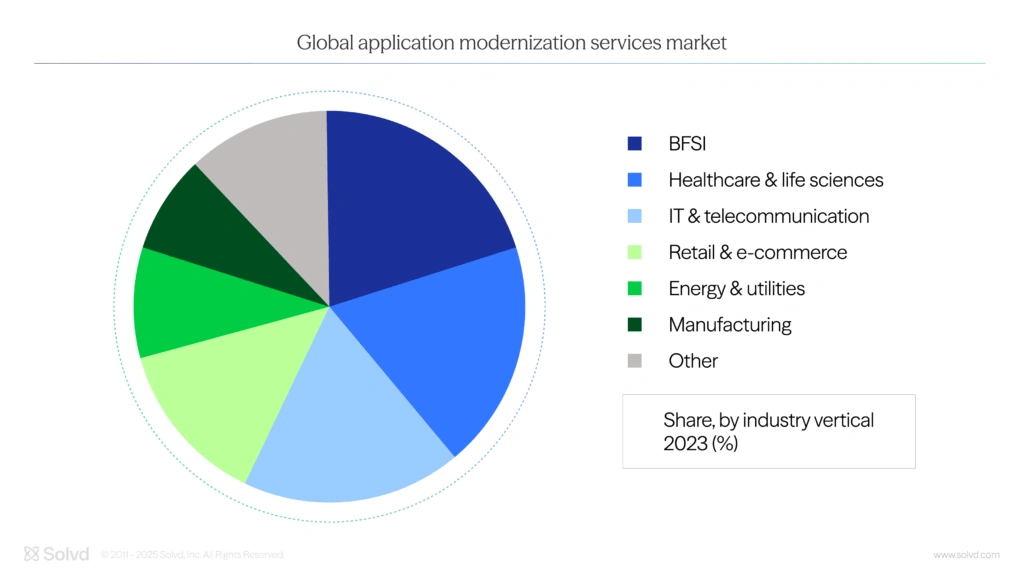
At the same time, finding the right approach to modernization is not always straightforward. A study by Red Hat identified the following key challenges in modernization efforts:

Legacy application modernization strategies
Legacy application modernization is a complex endeavor that requires a strategic approach. By carefully assessing current business needs and identifying modernization objectives, organizations can select the most suitable strategy from various options, including encapsulating, rehosting, replatforming, refactoring, rearchitecting, rebuilding and replacing. The ultimate goal is to deliver these objectives with minimal investment while maximizing the value derived from legacy systems.
Let’s discuss legacy application modernization strategies in more detail to understand their relevance and applicability in different situations.
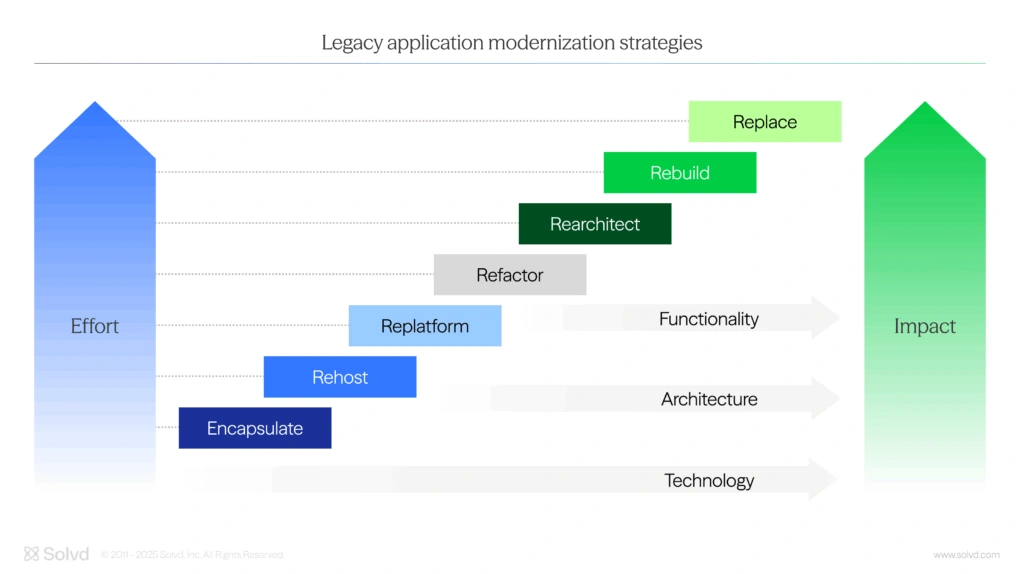
Encapsulating
One effective strategy for modernizing legacy applications involves encapsulation. This approach involves wrapping the legacy application with a modern interface or layer that can interact with newer technologies and systems. By encapsulating the legacy system, organizations can gradually modernize it without a complete overhaul, reducing the risk of errors and minimizing downtime. Encapsulation offers several key benefits:
- Preservation of core functionality. By preserving the core functionality of the legacy application, organizations can minimize disruption to business operations.
- Improved performance and scalability. Encapsulation allows for the integration of modern technologies, such as cloud computing and microservices, to improve performance and scalability.
- Enhanced security. Organizations can implement robust security measures to protect sensitive data by isolating the legacy application within a modern shell.
- Facilitated innovation. Encapsulation allows the development of new features and functionalities without modifying the underlying legacy code, accelerating innovation.
- Reduced costs. Organizations can significantly reduce the costs associated with modernization efforts by avoiding a complete rewrite.
However, it’s important to note that encapsulation is not a one-size-fits-all solution. Careful consideration must be given to the specific characteristics of the legacy application and the organization’s overall modernization goals. A detailed assessment of the application’s complexity, dependencies, and future roadmap is essential to determine the suitability of encapsulation.
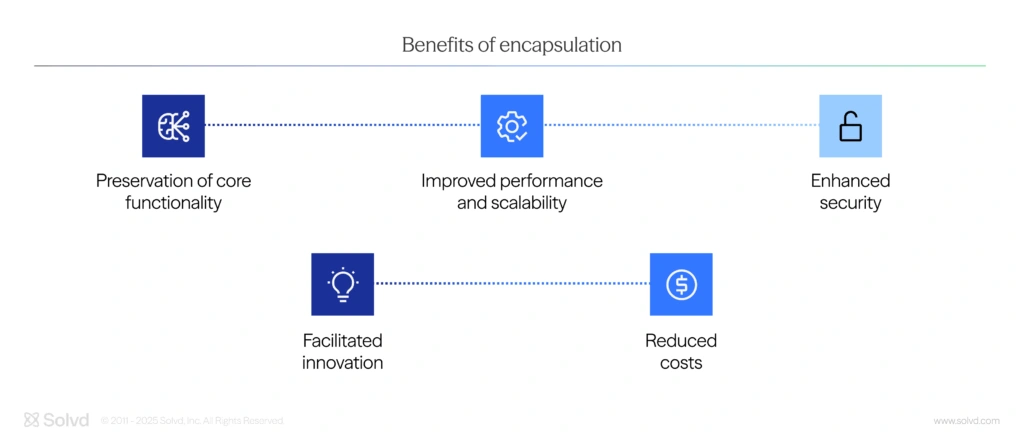
Rehosting
Rehosting, a common approach to legacy system modernization, involves simply moving an existing application to a new platform without altering its code. While it might seem like a straightforward solution, it is often a double-edged sword.
On the one hand, rehosting can offer a quick win. It’s a relatively low-risk, low-cost way to extend the life of a legacy system, especially if the system is still performing its intended function. For example, a company might rehost a critical financial system to a cloud platform to improve scalability and disaster recovery.
On the other hand, rehosting can be a missed opportunity. It doesn’t address the legacy system’s underlying technical debt or outdated architecture. In fact, it can keep these problems existing by locking the organization into a maintenance burden. Imagine rehosting a monolithic application that is difficult to understand or modify. While the new platform might provide performance benefits, the fundamental challenges remain.
Think of rehosting a legacy system as putting a new engine in an old car. While the engine might be more powerful, the car’s overall design and features are still outdated.
If your goal is to truly modernize your legacy systems and get the benefits of cloud technology, rehosting might be a temporary solution, but it’s not a long-term strategy. To achieve true transformation, you’ll need to consider more comprehensive approaches like refactoring, rebuilding, or replacing the system entirely.
Replatforming
Replatforming, often confused with rehosting, is a strategic transformation that goes beyond simply moving an application from one infrastructure to another. It involves a deep-seated modernization that uses modern technologies and architecture to improve performance, scalability, and maintainability.
While rehosting merely transplants an application to a new platform, often leaving its original structure, replatforming is a more radical approach. It involves redesigning the application to utilize the new platform’s capabilities. For instance, a monolithic application can be broken down into microservices, each responsible for a specific function. This not only improves scalability but also facilitates independent development and deployment.
Another key aspect of replatforming is the adoption of cloud-native technologies. Containers and serverless functions, for example, can significantly reduce operational costs and increase agility. By leveraging these technologies, organizations can create more flexible and responsive applications.
Consider a legacy banking system. Rehosting this system to the cloud might improve performance and reduce costs, but it wouldn’t address the original architecture’s underlying technical debt or limitations. Replatforming, on the other hand, would involve breaking down the system into smaller, more manageable components, adopting modern APIs, and potentially even migrating to a cloud-native architecture. This would not only improve the system’s performance and scalability but also make it easier to maintain and innovate.
Overall, replatforming is a strategic decision that requires careful planning and execution. It’s not just about moving to a new platform; it’s about transforming the application to take full advantage of modern technologies and architectures. By doing so, organizations can improve their competitiveness, reduce costs, and accelerate innovation.
Refactoring
Refactoring legacy systems is similar to renovating a historic mansion. While the bones might be solid, the interior decor is outdated, and the plumbing is prone to leaks. The goal is to modernize without losing the character or functionality of the original structure.
One common approach is strangler fig refactoring. Named after the parasitic plant that envelops and eventually kills its host, this strategy involves gradually replacing components of the legacy system with new, modernized ones. It’s like slowly replacing the old wiring in your house without turning off the power. While it might be a bit risky, it allows the system to remain operational throughout the process.
Another approach is big bang refactoring. It’s like gutting the entire house and rebuilding it from scratch. While it’s a more disruptive and risky approach, it can result in a wholly modernized system with fewer technical debts. However, if something goes wrong during the rebuild, you’re left without a place to live.
A more nuanced approach is incremental refactoring. This involves making small, targeted improvements to the legacy system over time. It’s like gradually replacing the furniture in your house with more modern pieces. While it might not result in a complete overhaul, it can improve the system’s performance and maintainability.
One of the biggest challenges in refactoring legacy systems is technical debt. This is the accumulated cost of making poor design choices or shortcuts in the past. It’s like living in a house with a leaky roof and a faulty electrical system. Addressing technical debt is essential for modernizing a legacy system, but it can be a challenging task.
In conclusion, refactoring legacy systems is a complex and challenging undertaking. It requires a careful balance of risk, disruption, and long-term benefits. Businesses can successfully modernize their legacy systems and pave the way for future innovation by choosing the right approach and addressing technical debt.
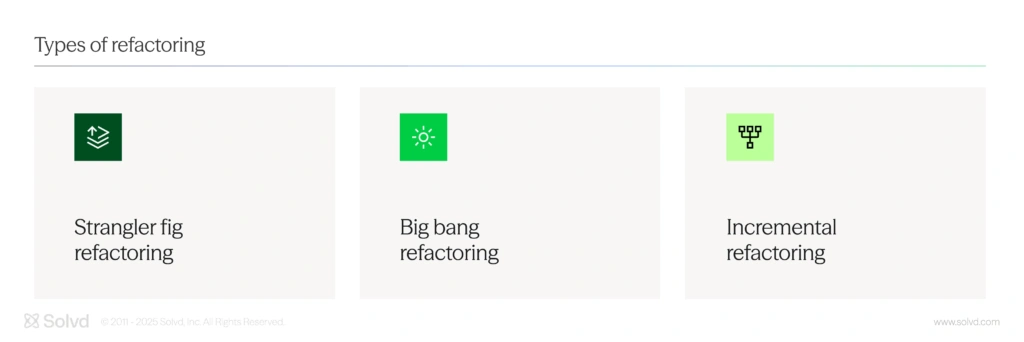
Rearchitecting
Rearchitecting is a strategic approach to legacy application modernization that involves a comprehensive redesign of the application’s architecture. This process aims to improve the system’s performance, scalability, maintainability, and overall alignment with modern technological standards.
While various modernization strategies exist, companies often opt for rearchitecting due to several key factors. Firstly, rearchitecting allows organizations to address fundamental issues within their legacy systems, such as poor performance, scalability limitations, and outdated technology stacks. By redesigning the architecture, companies can build a more robust and flexible foundation for their applications.
Secondly, rearchitecting provides an opportunity to incorporate modern development practices and technologies. This can lead to significant improvements in terms of development speed, agility, and the ability to respond to changing business needs. Organizations can streamline their development processes and reduce technical debt by adopting newer technologies and methodologies.
Furthermore, rearchitecting allows companies to enhance the user experience and improve the overall quality of their applications. By redesigning the user interface and optimizing the application’s performance, organizations can deliver a more seamless and efficient user experience. This can lead to increased user satisfaction and productivity.
In conclusion, rearchitecting is one of the most powerful legacy application modernization strategies. Organizations can significantly enhance the value and longevity of their software systems by addressing fundamental issues, incorporating modern technologies, and improving user experience.
What constitutes good code stays the same whether that code is for a trading business or a sandwich-ordering system, but what constitutes good architecture varies widely. It’s all in the choice and balance of reliability, maintainability, scalability, flexibility, and so on. You have to decide which are important to you and then use them to drive your architectural decision-making.
Rebecca Parsons, Strategic Technology Consultant
Rebuilding
Rebuilding legacy applications involves a complete overhaul, discarding the old codebase and starting afresh with modern technologies. This approach is often chosen when legacy systems are severely outdated, inflexible, or unable to meet evolving business needs. Companies may opt for rebuilding when the technical debt accumulated over time becomes too burdensome, hindering innovation and increasing maintenance costs. Additionally, a complete rebuild may be the most efficient solution if the existing system’s architecture is fundamentally flawed or incompatible with modern development practices.
While other legacy application modernization strategies like rehosting, replatforming, and refactoring can be effective in specific scenarios, rebuilding offers distinct advantages. For instance, rebuilding allows for a clean break from technical debt, allowing the creation of a system that aligns perfectly with current best practices and emerging technologies. It provides an opportunity to optimize the application’s architecture, improve performance, and enhance user experience. Moreover, rebuilding can facilitate the integration of new features and functionalities more seamlessly, as the system is built from the ground up to accommodate future growth and change.
In conclusion, the decision to rebuild a legacy application is often driven by the desire to eliminate technical debt, improve performance and scalability, enhance user experience, and align with modern development practices. While it requires significant upfront investment and effort, the long-term benefits of a wholly modernized system can outweigh the initial costs.
At least 40% of all businesses will die in the next 10 years if they don’t figure out how to change their entire company to accommodate new technologies.
John Chambers, Chairman Emeritus at Cisco
Replacing
The “drop and shop” or repurchase modernization strategy involves replacing an existing legacy application with a Commercial Off-The-Shelf (COTS) or Software as a Service (SaaS) solution. This approach entails eliminating the former application and its subsequent replacement with a ready-made product from the market.
Key considerations when implementing this strategy include:
- Alignment with new requirements and needs: The chosen COTS or SaaS solution must effectively address current and future business needs, ensuring seamless integration with existing systems and processes.
- Vendor selection and evaluation: A thorough evaluation process is crucial to identify a vendor that offers a reliable, scalable, and cost-effective solution that meets organizational requirements.
- Data migration and integration: Careful planning is necessary to migrate data from the legacy system to the new solution, ensuring data integrity and accessibility.
It is essential to distinguish between replacing and rebuilding a legacy system. While replacing involves substituting the legacy system with a pre-existing solution, rebuilding entails creating a new system from the ground up, often incorporating modern technologies and architectures. The choice between these two approaches depends on various factors, including the complexity of the legacy system, the availability of suitable COTS or SaaS solutions, and the organization’s specific needs and resources.
Legacy system modernization checklist
Do you need to complete a legacy system modernization? Use the following self-checklist to evaluate the situation with your business.
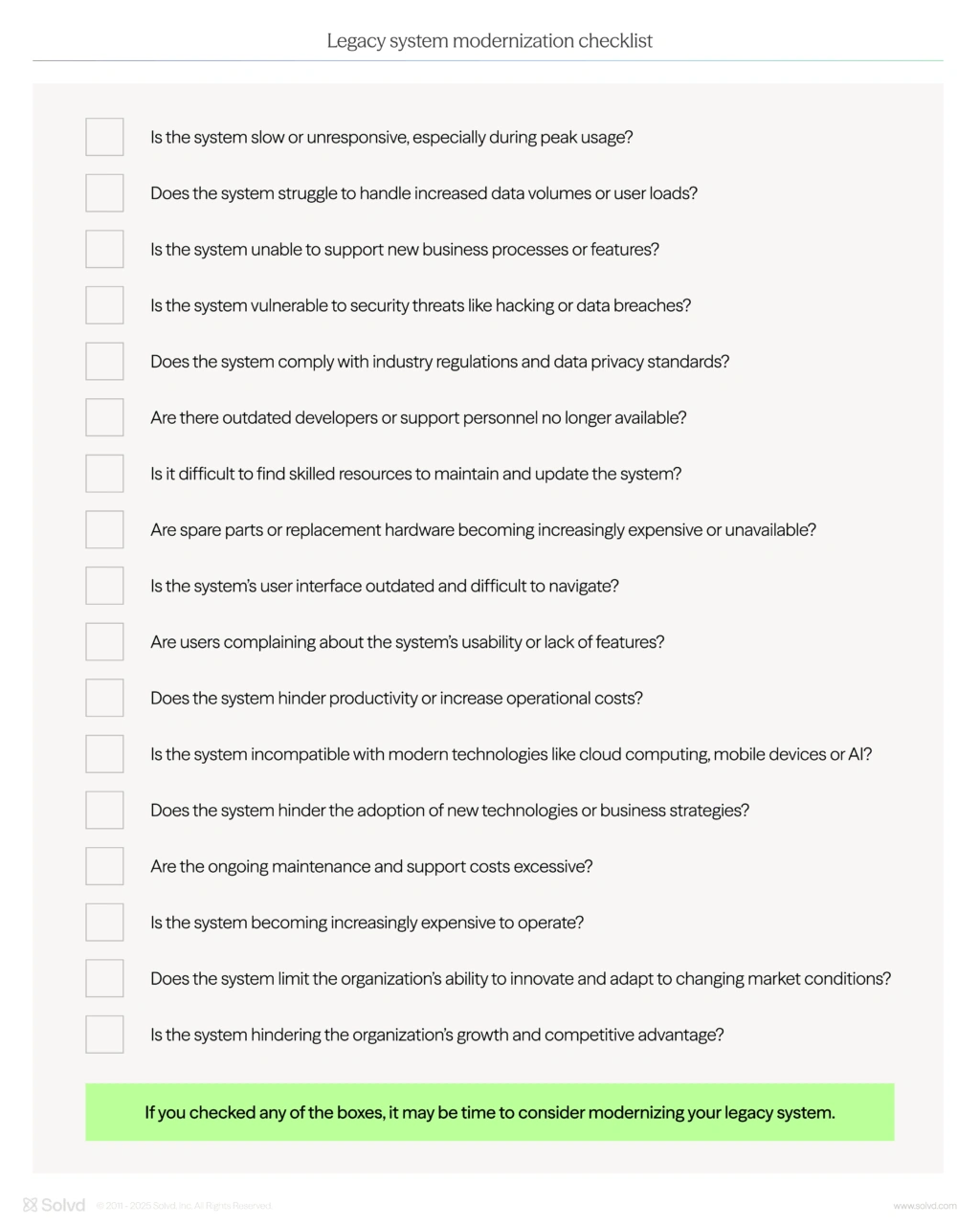
If you answered “yes” to any of these questions, it may be time to consider modernizing your legacy system.
Key questions to answer when choosing the legacy application modernization strategy
Are you modernizing for modernization’s sake? It’s a common trap. Organizations often embark on application modernization projects without clearly understanding why they’re doing it. They see the buzzwords, the promises of increased efficiency, and the fear of falling behind, but they lack a solid foundation of business requirements. Think of application modernization as a surgical procedure. The surgeon doesn’t simply cut and sew; they carefully consider the patient’s medical history, symptoms, and desired outcome. Similarly, your legacy application modernization strategy should be driven by a deep understanding of your business requirements.
What are your specific goals? Are you looking to improve customer satisfaction, reduce costs, increase efficiency, or gain a competitive edge? Whatever your objectives, they should be clearly articulated and prioritized.
How will modernization help you achieve these goals? What new capabilities will your modernized applications provide? How will they improve your business processes? What tangible benefits can you expect to see?
Consider answering the following questions when defining your business requirements:
- What are your customers’ needs and expectations? How can modernization improve their experience?
- What are your competitors doing? How can you differentiate yourself through modernization?
- What are your long-term strategic goals? How does modernization fit into your overall business strategy?
- What are the potential risks and challenges? How can you mitigate them?
By carefully defining your business requirements, you can ensure that your application modernization strategy is not just a technical exercise but a strategic investment that delivers real value to your organization.
How to select the right application modernization approach for your organization
Just like you’d consult a doctor for a severe health issue, you should consult experts when it comes to modernizing your legacy applications. The right strategy depends on a wide range of factors, including the age and complexity of your applications, your business objectives, and your team’s capabilities.
Solvd, with its deep expertise in application modernization, can help you:
- Assess your current state. Understand the health of your legacy applications and identify potential risks.
- Develop a tailored strategy. Create a modernization roadmap that aligns with your business goals.
- Execute the plan. Leverage our technical expertise and industry best practices to ensure a smooth transition without disruptions for the business.
- Provide ongoing support. Ensure your applications remain modern and relevant.
Don’t gamble with your organization’s future. By partnering with Solvd, you’re investing in a proven approach to application modernization that will deliver substantial results.
Wrapping up
Einstein once said, “Insanity is doing the same thing over and over again and expecting different results.” Yet, many organizations persist in ‘maintaining’ legacy systems, hoping against the hope that they’ll magically become more efficient and secure. It’s time to break free from this cycle of technological madness.
Legacy applications are like old houses: they still stand, but they are creaky, inefficient, and a security risk. Modernization isn’t just about shiny new tech, it’s about unlocking your business’s potential. Upgrade your legacy systems, and you’ll upgrade your entire operation. It’s not just about keeping up, it’s about getting ahead.









